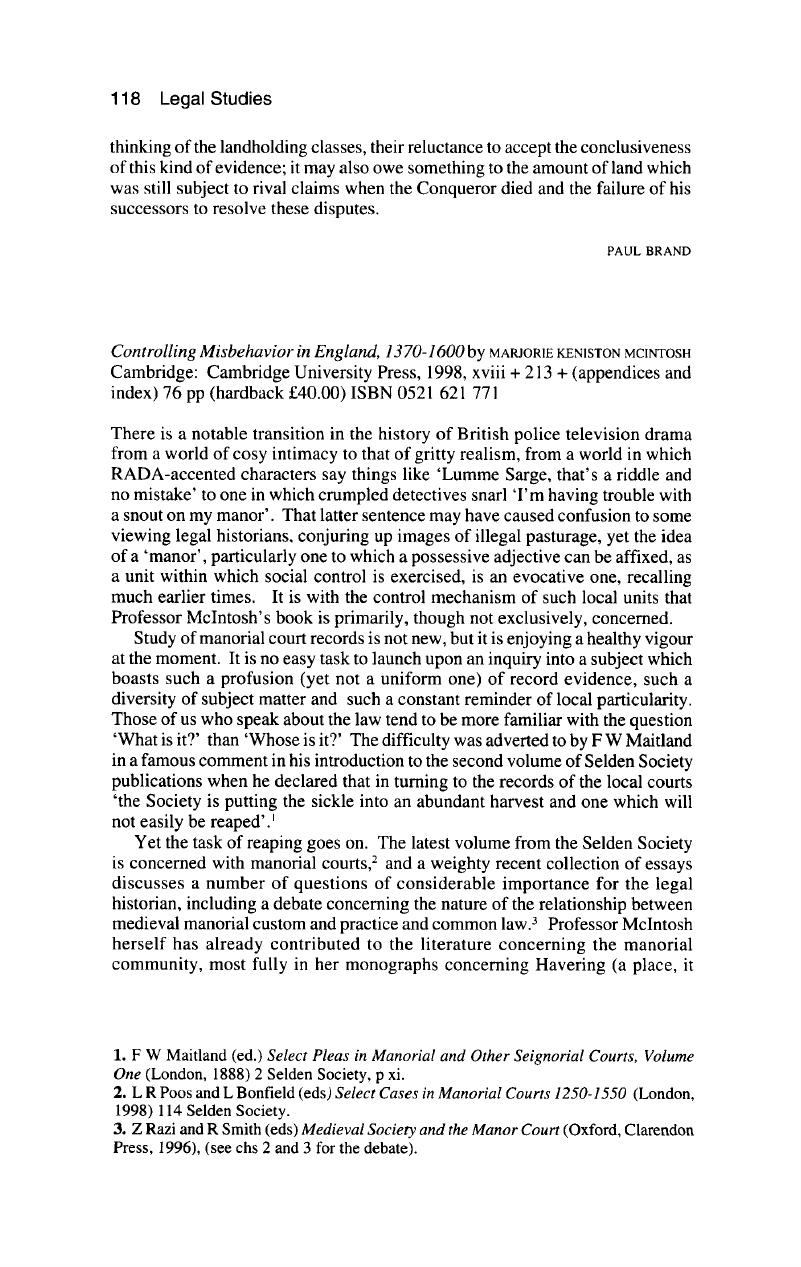No CrossRef data available.
Published online by Cambridge University Press: 02 January 2018

1. F W Maitland (ed.) Select Pleas in Manorial and Other Seignorial Courts, Volume One (London, 1888) 2 Selden Society, p xi.
2. L R Poos and L Bonfield (eds) Select Cases in Manorial Courts 1250-1550 (London, 1998) 114 Selden Society.
3. Z Razi and R Smith (eds) Medieval Society and the Manor Court (Oxford, Clarendon Press, 1996), (see chs 2 and 3 for the debate).
4. M McIntosh Autonomy and Community: The Royal Manor of Havering, 1200-1500 (Cambridge: Cambridge University Press, 1986); A Community Transformed: The Manor and Liberty of Havering 1500-1620 (Cambridge: Cambridge University Press, 1991). See also Razi and Smith, above n 3, pp 32–33.
5. The period 1370-1400 (p 47).
6. For the limits of this investigation see pp 29-31, Appendix 1.2, 1.3. Note that the role of Assizes is not examined (Assize justices…rarely dealt with misconduct [ie of the kind studied here] before the late sixteenth century’ (p 26)). For the relationship between JPs and Assize judges in the fifteenth century see E Powell Kingship, Law and Society: Criminal Justice in the Reign of Henry V (Oxford: Clarendon Press, 1989) pp 58 et seq.
7. This employs records of Poll Tax 1377-81, Lay Subsidies of 1334 and 1524/5 and Hearth Taxes of the 1660s and 1670s. Clearly there are problems in working from these sources, see the discussion at pp 151-152 and Appendix 6.4.
8. Chapter 8 in particular carries references which range from a text concerning stained glass to theories of hegemonic discourse!
9. I have a fantasy which involves speculating as to how different our picture of legal history would be had Maitland gone to, say, St Andrews and tourist boards had saturated academic common rooms with posters saying ‘Derby: It's So Bracing’, or ‘Wakefield: It's Where The Actions Are’ . No one is obliged to share in this fantasy. Incidentally, Cambridge University Press seem to have no doubt as to the major market for this book - its spelling is unapologetically American throughout.
10. Cf. The rather different invocation of Foucauldian theory here at p 117, n 38.
11. See E Powell ‘Social Research and the Use of Medieval Criminal Records’ in (1981) 79 Michigan LR p 967 and ch 4 of the same author's Kingship (supra, n 6).
12. These are apparently ‘defined largely on the basis of how local people described the offences in their presentments, the kinds of social thinking that underlay their specific concerns…’ (p 171). Clearly the same action or series of actions could, particularly as levelled at specific individuals at different times and in different places, be motivated by a number of factors and represent a number of concerns. See, for McIntosh's comments, pp 55, 171. Moreover it seems that the descriptive language is not constant (p 70). The ‘disorder’ cluster in particular seems to me to be particularly nebulous in both definition (p 68) and content.
13. See pp 60 et seq. And note 10. Being an idler and giving hospitality to one are also taken together, as may be (I am not sure from the example at p 76) keeping a disorderly alehouse and frequenting alehouses too much.
14. See J Post ‘The Justice of Criminal Justice in Late-Fourteenth-Century England’ in (1986) VII Criminal Justice History p 33 at p 35.
15. See R Palmer English Law in the Age of the Black Death (Chapel Hill and London: University of North Carolina Press, 1993).
16. J Beckerman ‘Procedural Innovation and Institutional Change in Medieval English Manorial Courts’ (1992) 10 Law and History Rev 197 at 247
17. I have in mind also the possible impact of declining seignorial juridiction, which in respect of leyrwite and, surely, the regulation of subtenancy may be significant. More generally, if we view a court not simply as a forum for social concern but also as a source of finance and prestige such variation becomes potentially more important.
18. Interestingly, McIntosh does refer to a decline in the use of arbitration in the second half of the sixteenth century and links it to a decline in concern with social harmony as supported in her survey (p 190). My point about the possible complexity (and possibly variant local rate of transition) remains: ie that, while of course the bringing of matters into court from outside is an event of considerable significance, the technique of regulation need not be determined solely by increased levels of activity or ‘community’ concern. To record a transition (or the possibility of a transition) is not to explain it.
19. Quoted by D Guth ‘Enforcing Late-Medieval Law: Patterns in Litigation during Henry VII's Reign’ in J Baker (ed) Legal Records and the Historian (London, 1978) p 80. Note Beckerman's argument that presentment was adopted as a procedure in the interests of lords: ‘Procedural Innovation’ p 232. Note also McIntosh's case at p 113.
20. She would presumably argue that the size of the sample would tend to minimise such particular variation.
21. I should point out that I have not examined any of the manuscript sources myself and can offer therefore no opinion on their transcription, translation etc. I have no reason to have any doubts, and Professor McIntosh certainly seems confident (p 52), but I mention this for the sake of completeness. One small point I did note was a reference to ‘the Statute of Winton of 1285’ (p 66): surely the Statute of Winchester?